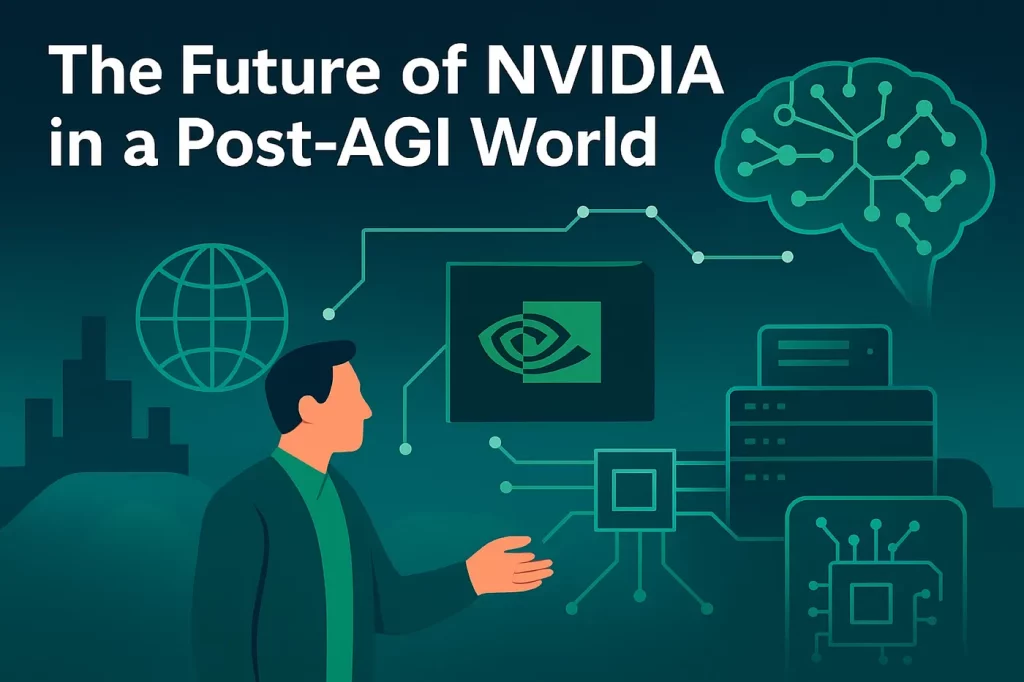In a world where artificial intelligence (AI) has transcended science fiction to become the backbone of the global economy, NVIDIA stands as an undisputed titan. A decade ago, the company was synonymous with graphics cards for gamers and content creators. Today, with a market capitalization nearing $4 trillion, NVIDIA has pivoted dramatically to the epicenter of the AI revolution. But what happens when Artificial General Intelligence (AGI)—AI capable of performing any human intellectual task—becomes a reality? In this comprehensive and detailed article, we’ll explore how AGI could reshape NVIDIA’s business model, transforming it from a hardware provider to the essential glue of the massive data centers powering AI. We’ll dive into its evolution, its financial investments in infrastructure, and reflect on whether we’re witnessing the rise of a financial-technological holding company of the future.
If you’ve followed recent news, you know NVIDIA is no longer just selling GPUs. It’s pouring billions into the very data centers its chips power, forging partnerships that go far beyond technical support or software. Its recent deal with BlackRock is a prime example of this bold shift. Join us for an in-depth analysis, optimized for WordPress, backed by current data, and enriched with forward-looking insights.
The Rise of AGI: A Paradigm Shift NVIDIA Can’t Ignore
AGI represents the holy grail of AI: systems that not only learn from specific datasets, as current generative AI models do, but reason, generalize, and adapt like humans. Experts like Sam Altman of OpenAI predict AGI could emerge within the next 5-10 years, driven by breakthroughs in scalable computing. When it does, the demand for computational power will skyrocket. We’re not talking about isolated servers but AI factories—hyperscale data centers with gigawatts of capacity, designed to train models with trillions of parameters.
So far, AI has relied heavily on NVIDIA’s GPUs, such as the H100 and Blackwell series, which command 80-90% of the AI training market. However, AGI will demand more than powerful chips. It will require integrated ecosystems: ultra-fast interconnects (thanks to NVIDIA’s 2020 acquisition of Mellanox), optimized software like CUDA, and—critically—physical infrastructure to manage massive energy consumption. According to Ark Invest, the AI data center market could reach $1.4 trillion in the next decade, with a 21% compound annual growth rate. NVIDIA, generating 80% of its revenue from data centers ($18.4 billion in Q4 2024), is poised to capture a disproportionate share of this market.
NVIDIA’s role as the glue emerges here: its technologies bind hardware, software, and energy into a cohesive system. Picture a data center where GPUs not only compute but orchestrate data flows, optimize cooling, and predict failures using real-time AI. This isn’t speculation; it’s the vision articulated by Jensen Huang, NVIDIA’s CEO, at GTC 2025. The company is positioning itself as the architect of these AI factories, ensuring its technologies are indispensable at every layer.
From GPUs to Ecosystems: The Evolution of NVIDIA’s Business Model
Historically, NVIDIA operated a hardware-centric model: it designed and manufactured GPUs, sold them to PC makers, cloud providers, and data centers, and provided support through software like NVIDIA AI Enterprise. In 2022, data centers accounted for 40% of its revenue; by 2025, this figure exceeds 80%, with a staggering 400% growth in the AI-driven segment. Yet, this model has limitations. Competition from AMD and custom chips by Google or Amazon squeezes margins, and supply chain vulnerabilities pose risks.
AGI accelerates NVIDIA’s shift to an integrated platform model. The company no longer sells just chips; it offers complete systems like the DGX SuperPOD, which integrates thousands of GPUs into AI-ready clusters. Beyond hardware, NVIDIA is investing in the surrounding ecosystem:
- Networking and Storage: Through InfiniBand and Ethernet solutions from Mellanox, NVIDIA controls 70% of the AI data center interconnect market, enabling GPUs to communicate at speeds up to 800 Gbps.
- Software as a Service: CUDA and tools like Omniverse lock developers into NVIDIA’s ecosystem, creating a moat that will be critical in the AGI era, as migrating code to competitors becomes costly.
- Energy Optimization: AI data centers consume energy on the scale of entire cities (one gigawatt powers ~750,000 homes). NVIDIA collaborates on modular designs like the Kyber rack, reducing energy use by 3-5% through liquid cooling and digital modeling.
As Huang stated at Computex 2025, “Traditional data centers are becoming AI factories, and NVIDIA provides the complete blueprint.” NVIDIA is transitioning from a supplier to an architect, monetizing not just initial hardware sales but recurring upgrades (every 3 years due to GPU obsolescence) and managed services. This shift positions NVIDIA to dominate the AGI infrastructure landscape, where computational demands will dwarf today’s requirements.
Financial Investments: NVIDIA as a Strategic Partner
The game-changer lies in NVIDIA’s direct investments in data centers, moving beyond the role of a vendor. This isn’t about software or support—it’s venture capital in physical infrastructure, ensuring NVIDIA’s GPUs are the beating heart of these “energy beasts.” Key 2025 milestones include:
| Investment/Deal | Details | Impact |
|---|---|---|
| OpenAI Partnership | Up to $100 billion to deploy 10 gigawatts of NVIDIA systems (~4-5 million GPUs). Initial phase in 2026 with Vera Rubin platform. | Secures massive chip sales and introduces a leasing model: OpenAI pays in installments, NVIDIA recoups via GPU leasing (up to 5 years), ensuring recurring revenue. |
| Intel Collaboration | $5 billion in Intel shares to co-develop x86 CPUs with NVLink for data centers and PCs. | Expands NVIDIA’s ecosystem to CPUs, diversifying beyond GPUs and strengthening integration. |
| Startup Investments | $700 million in Nscale (UK data centers) and $250 million in CoreWeave (GPU cloud). | Locks in exclusive demand for NVIDIA hardware from specialized AI clouds. |
| Stargate Project | $500 billion plan with Oracle, SoftBank, and OpenAI for global data centers. | Global scale, targeting energy-rich regions like the UAE, ensuring long-term infrastructure dominance. |
These investments, fueled by NVIDIA’s $30 billion in free cash flow in 2024, transform the company into a stakeholder in the infrastructure it powers. By owning a piece of the data center ecosystem, NVIDIA captures value across the entire lifecycle, from construction to operation.
The BlackRock Deal: A Watershed Moment
On October 15, 2025, a consortium led by BlackRock, alongside NVIDIA, Microsoft, xAI (Elon Musk’s venture), MGX (Abu Dhabi), and Temasek (Singapore), acquired Aligned Data Centers for $40 billion. Aligned operates 80 facilities with 5 gigawatts of capacity across the U.S. and Latin America, marking the largest data center deal in history. Formed in 2024 as the AI Infrastructure Partnership (AIP), this group plans to deploy $30 billion in equity, scalable to $100 billion with debt. Larry Fink, BlackRock’s CEO and AIP chairman, called it “delivering the infrastructure for the future of AI.”
For NVIDIA, this deal secures priority compute capacity for its chips while leveraging BlackRock’s financial muscle. Posts on X captured the excitement: “This isn’t about apps—it’s about the power grid for AI. Whoever controls compute controls the future,” wrote @CaldeiraMichael. @PeterHeidkamp added, “NVIDIA, Microsoft, and BlackRock in a $40B deal for Aligned—the power of AI in action.” This move cements NVIDIA’s role as a linchpin in the AI ecosystem, aligning financial and technological giants.
Expanding the Vision: NVIDIA’s Role in the AGI Economy
The implications of NVIDIA’s strategy extend beyond data centers. AGI will reshape industries—healthcare, finance, transportation, and more—requiring unprecedented computational scale. NVIDIA’s investments position it to power not just AI training but inference at the edge (running AI models in real-world applications). For example, its Jetson platform is already embedded in autonomous vehicles and robotics, which will demand AGI-level processing. By 2030, McKinsey estimates the AI economy could contribute $15 trillion to global GDP, with compute infrastructure as the critical bottleneck. NVIDIA’s early mover advantage gives it a head start.
Moreover, NVIDIA is exploring sustainability as a differentiator. AGI data centers will face scrutiny over their environmental impact, given their energy demands. NVIDIA’s work on energy-efficient designs, such as liquid-cooled racks and AI-optimized power management, could set industry standards. Partnerships with renewable energy providers, hinted at in discussions with NextEra Energy, suggest NVIDIA is preparing for a future where green compute is a competitive edge.
Reflection: A Financial-Technological Holding in the Making?
Is NVIDIA evolving into a financial-technological holding company? The evidence strongly suggests so. Much like Berkshire Hathaway aggregates diverse businesses under a financial umbrella, NVIDIA is building a portfolio of strategic assets: data centers, startups, and even CPU development via Intel. Its investments generate returns not just through hardware sales but through equity stakes and long-term leasing models. In the AGI era, NVIDIA could launch its own infrastructure funds, attracting institutional investors like BlackRock and sovereign wealth funds.
This model isn’t without risks. Regulatory scrutiny, such as antitrust concerns over the OpenAI deal, could intensify. The IMF has warned of potential AI market bubbles, and geopolitical tensions over chip supply chains (e.g., U.S.-China restrictions) remain a threat. Yet, the upside is immense. As Huang declared, “Accelerated computing is sparking a multi-decade supercycle for data centers.” NVIDIA’s ability to integrate finance, technology, and infrastructure positions it to dominate this supercycle.
Conclusion: NVIDIA, the Architect of AGI
AGI will redefine industries, economies, and societies, and NVIDIA is crafting the glue that holds it together. From selling GPUs to investing in gigawatts of compute power, its trajectory is a masterclass in blending finance and technology. Whether you’re an investor, developer, or simply curious, now is the time to watch: the future of AI is being built on interconnected networks led by visionaries like Huang.
Sources: Reuters, CNBC, NVIDIA Newsroom, and discussions on X (October 2025).



